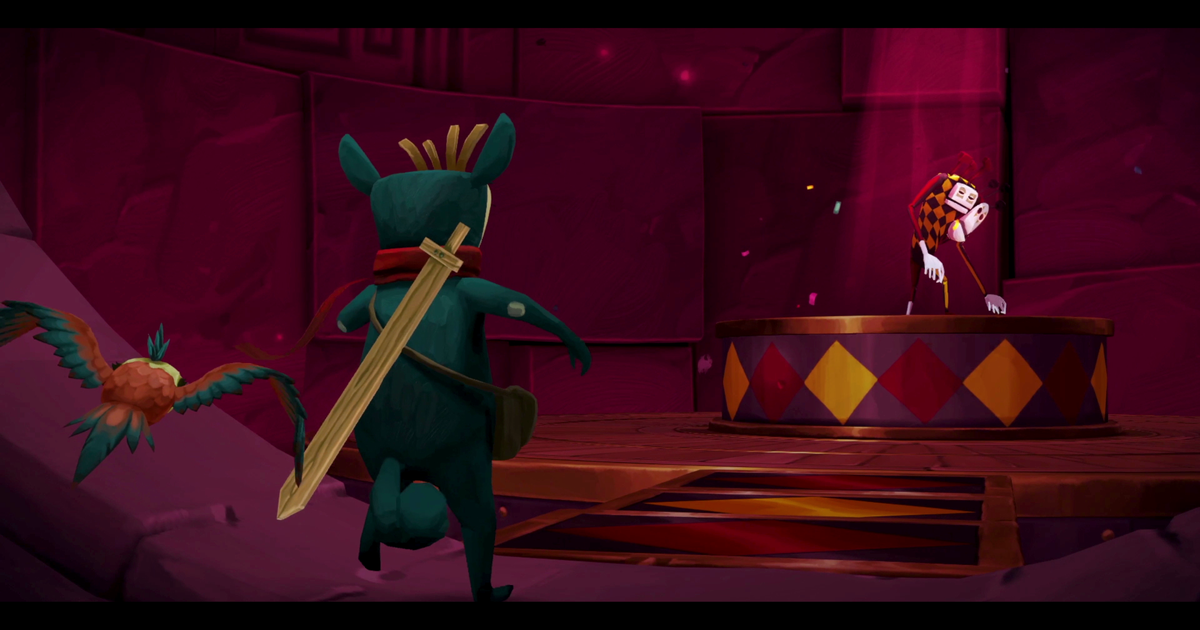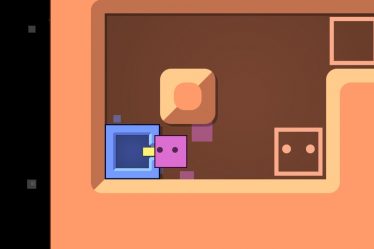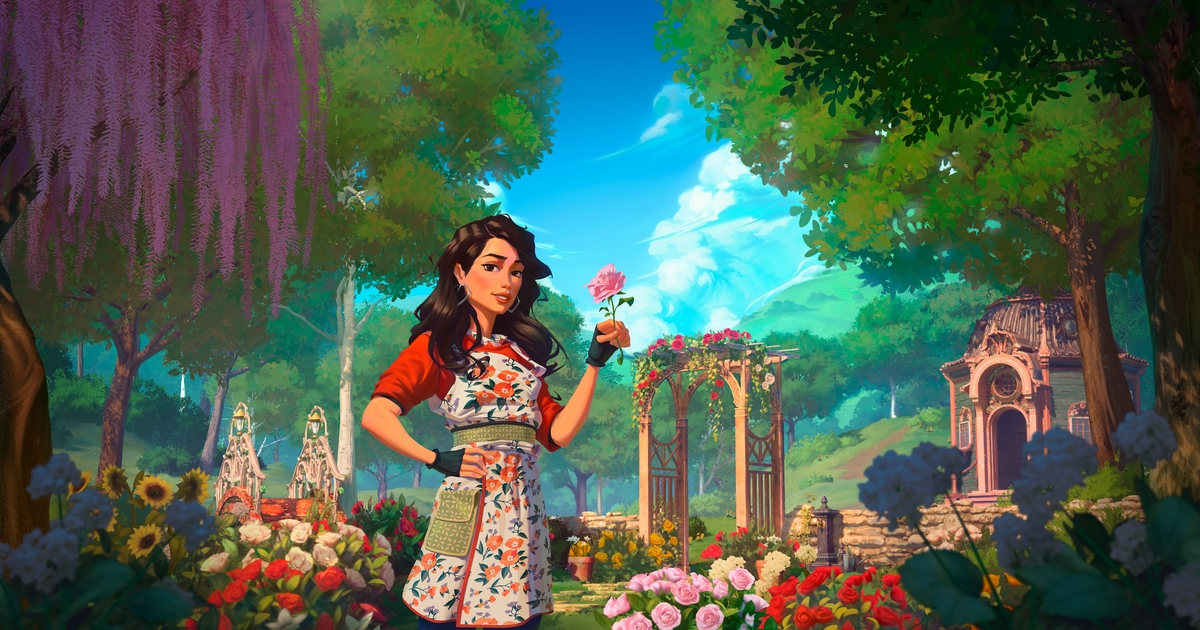
Game Developer Deep Dives are an ongoing series with the goal of shedding light on specific design, art, or technical features within a video game in order to show how seemingly simple, fundamental design decisions aren’t really that simple at all.
Earlier installments cover topics such as how Mimimi games
crafted the save scum-friendly save system in Shadow Gambit: The Cursed Crew, and the technical work and creative nuances behind Slime Rancher 2‘s new weather system and the experiential impact that developers Monomi Park designed for players, and the marketing strategy that helped Timberborn‘s popularity soar with only two years in early access with Mechanistry comms manager Michal Amielanczyk.
In this edition, sound designer for stillalive studio Benedict Sanderson tells us about his creative vision for Garden Life and the whys and hows of achieving its dynamic ambient audio system.
I’m Benedict Sanderson, sound designer for stillalive studios. I’ve worked at our Austrian studio for nearly three years now, and I was lucky enough to have the chance to flex my musical chops for our latest game, Garden Life: A Cozy Simulator. The game is just that: a relaxing, charming experience in which you can develop your own garden with all manner of decorative flowers and objects, with a beautiful art style, soothing music and audio.
There are plenty of games out there where you can grow plants with a “cozy” moniker or vibe—Stardew Valley and Harvest Moon come to mind—but we wanted to create something with much less “work” to do, where you can really get creative and chill out in your own little space. The play area is quite small in our game, and there’s no large world to explore, apart from the local town and shop, you just have your little garden to hang out in and decorate how you please. However, even before adding any plants and decorations, the garden is jam-packed with little details to make it really feel alive.
Although Garden Life has “simulator” in the name, it takes quite a few liberties with realism. While a lot of the plants, their names, their colors, and their growth conditions take cues from real life (it pays to have an actual botanist as your project’s producer), there are plenty of “unrealistic” things that add to the fun and laid-back atmosphere. For example, plants don’t take days or weeks to grow; you can often see them bloom right in front of your eyes! So, rather than have realism as my main objective in the sound design, believability was instead what I set out to foster. Creating an audio experience which you can really get lost in—one which makes you feel you’re really there, and which you might even want to leave running in the background to enjoy the sounds—that was my main aim.
To do this, I set up some interesting technical systems, such as a semi-randomised background music system, and a dynamic ambience transition system for when you move from one area to the next. The game was developed in Unreal Engine 5, and FMOD Studio was used as our audio middleware, giving me lots of tools to create interesting audio systems.
The music system was great fun to make. Before the project was signed, a small team in our studio made a prototype of the game’s plant growth system, and upon seeing it, I thought I could make some simple, smooth background music to play over it. I knew straight away that a game like this would benefit greatly from having a rich, natural ambience, so I didn’t want anything too busy for the music. Instead, I made something which is essentially comprised of different musical building blocks, which all get pieced together randomly as the track plays, with lots of space in between phrases for the ambience to take center stage. I actually have my wife to thank for the “improvisational” style of it—she quickly gets tired of repetitive music, so I knew I should make something a bit different.
Of course, the whole soundtrack is very acoustic and “natural”. I performed a lot of the musical parts, which I feel was very important, as too much software instrument presence would take away from its real, natural feeling. We were also already having people say the game’s art style reminded them of Studio Ghibli films, so while I didn’t want it to sound grand and beautiful like Howl’s Moving Castle, I did want some of the quirky fun and naturalness of other Ghibli soundtracks like Kiki’s Delivery Service and Ocean Waves. Also, as it’s such a laid-back soundtrack, I didn’t have to be super precise and professional with the performance and timing, so it suited me and my skills just fine.
While there are some synth sounds and clean electric guitar lines dotted about, it’s predominantly acoustic guitar, piano, ukulele, and trumpet. As for software instruments and libraries, there’s a lot of stuff in the music and sound design from Spitfire LABS—check them out if you’re looking for great, interesting, and free sounds! The Pianobook community was a fantastic resource for finding free software instruments, such as mandolins and melodicas, and Orchestral Tools’ Loire library has some brilliant accordion and chalameau (a kind of French clarinet) that can be heard throughout the game. This combination of fun, quirky instruments was just what I wanted, and helped me evoke a fun, charming, “European” sound. It also feels appropriate for the region in which the game is set—although the game locale is fictional, it’s based on rural Austria or Germany.
So, for the composition. Imagine you’re in your garden, pottering around on a pleasant summer’s day. Your friend is sitting in the corner with an acoustic guitar, improvising a little tune. They have the vibe and the general chord sequence down, but they always play it a little bit differently—an extra note here and there; different timing to the musical arpeggios; a longer pause before the next phrase. Sometimes they go back to the “beginning” of the track, sometimes they go into a B or C section. You always have an idea of how it’s going to go, but it has that laid-back, improvisational quality to it which means you never know what exactly is coming next, and it doesn’t get tiring or repetitive. This is what I set out to create.
FMOD Studio gave me all the tools I needed to create this randomization. One music “event” is told to play at the start of an in-game day—an example can be seen in the screenshot here. Just like in a traditional DAW or music player, the playhead moves along the timeline, and as it hits something, a musical event is triggered. A yellow musical phrase could play; a green arrow could send the playhead back or ahead to a different part of the track; a blue looping section could trap the playhead, making it play silence for a while; and so on.
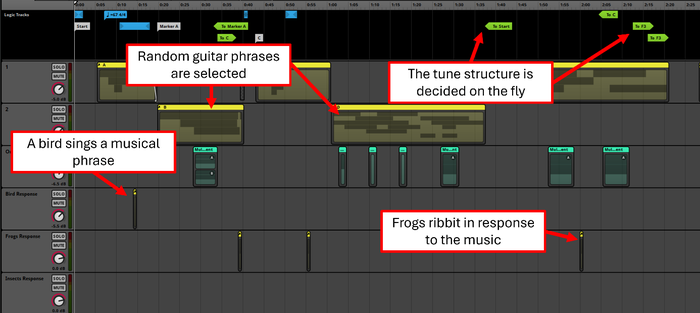
The basic layout of the “D” musical phrase. Image via stillalive studios.
Inside each musical block, there’s a shedload more variation going on. This screenshot shows inside the 4th phrase—the “D section” music block. Inside it, every green block contains several different performances of a phrase, and one is selected at random as the playhead activates it. The chord sequence is the same every time in this phrase, but different performances, inversions, and embellishments really bring the background music to life, helping to create a living, relaxing soundtrack.
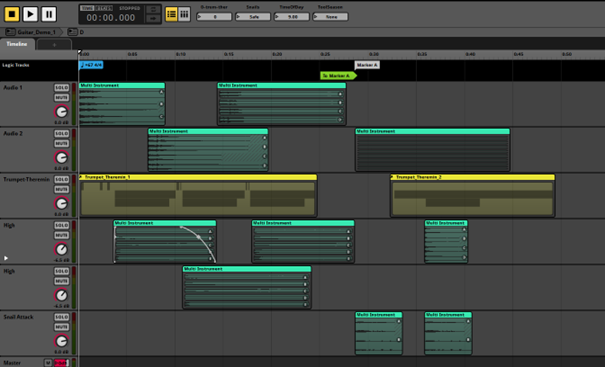
The “D” musical phrase. Image via stillalive studios.
Occasionally, natural sounds also play a part in the music. At certain points, birds, frogs, wind in trees, and other things will sound to fill in the gaps between musical phrases. I found this a great way to make the whole soundscape feel fuller and richer, without always having music playing. The bird response is my personal favourite of these sounds; a bird tweets a little ditty as a response to a musical phrase, in tune and in time with the music, and from the position of a tree in the garden. Did I actually teach a bird to sing the phrase and then record it? Or did I whistle it myself at a low pitch, then speed up the recording so that it sounds like a bird? I’m afraid that secret’s staying with me!
Of course, different game states also affect the music. If the end of the day is near, an extra layer will slowly come in, signifying that it’s time to wrap up. A mellow trumpet line or soft piano ditty will accompany the rest of the track, up until the church bells in the distance tell you it’s time to go home, at which point the music stops, allowing you to take in the sounds of the evening ambience. Hop on the bus and go home—a new tune is waiting for you tomorrow morning!
A more “classic” music system also happens in the village square, where the instrumentation changes as you move from one area to the next. I put a nice little twist on it though, making heavy use of FMOD’s transceivers, which can be thought of like walkie-talkies. All the music in the village square is played by an FMOD event, but none of it passes through the event’s main output; instead, the different instrument layers are transmitted to different receivers in the map, and are audible from there. This means that the quirky variation of the tune that exists in the shop can be heard coming from the shop doorway (it’s diegetic—in the world), but once you get inside the shop, it joins the rest of the instruments and becomes “2D

